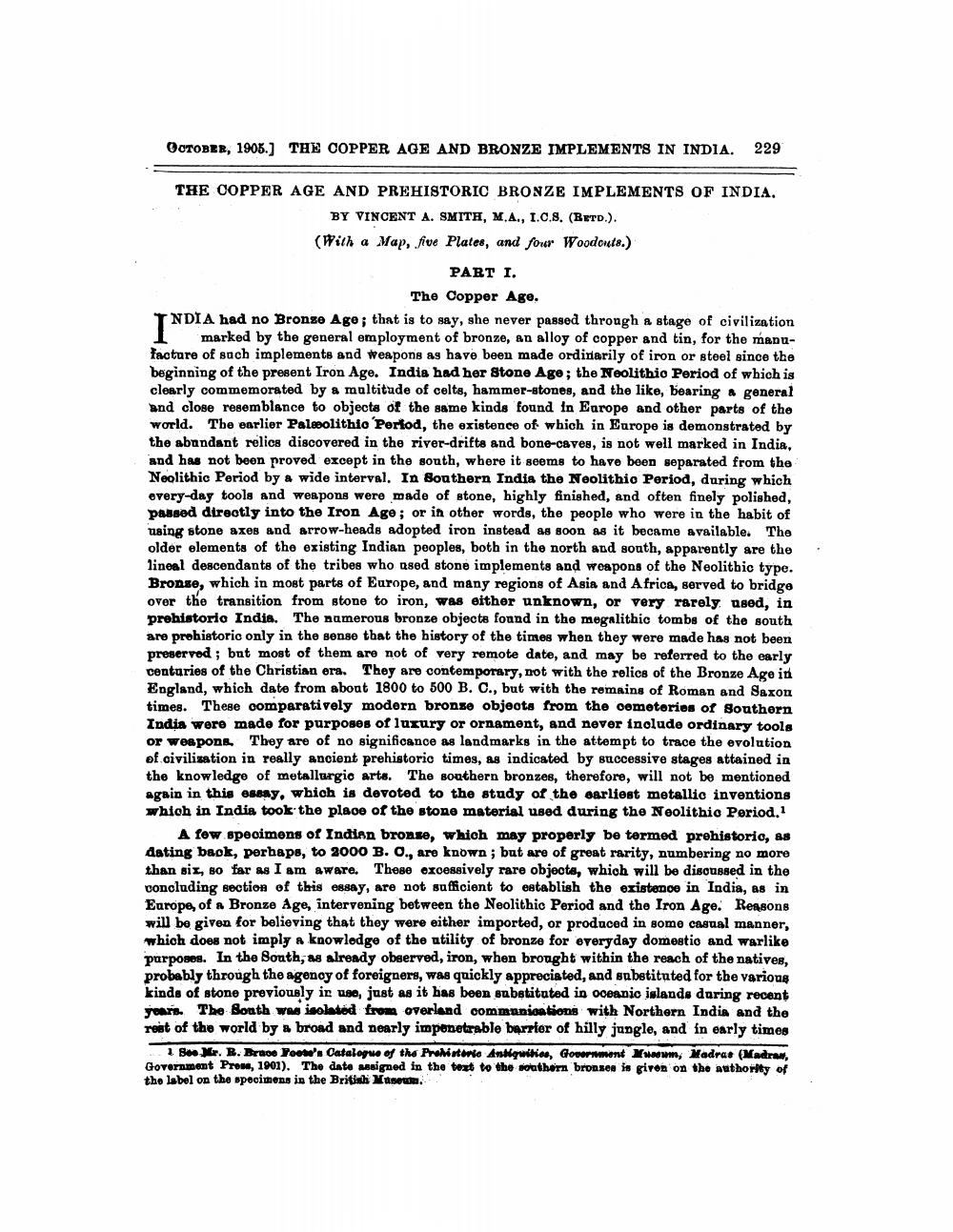________________
OTOBER, 1905.) THE COPPER AGE AND BRONZE IMPLEMENTS IN INDIA. 229
THE COPPER AGE AND PREHISTORIC BRONZE IMPLEMENTS OF INDIA.
BY VINCENT A. SMITH, M.A., 1.0.8. (BETD.). (With a Map, five Plates, and four Woodouts.)
PART I.
The Copper Age. INDIA had no Bronse Age; that is to say, she never passed through a stage of civilization
1 marked by the general employment of bronze, an alloy of copper and tin, for the manufacture of such implements and weapons as have been made ordinarily of iron or steel since the beginning of the present Iron Age. India had her Stone Age; the Neolithio Period of which is clearly commemorated by a multitude of celts, hammer-stones, and the like, bearing a general and close resemblance to objects of the same kinds found in Europe and other parts of the world. The earlier Paleolithio Perlod, the existence of which in Europe is demonstrated by the abandant relics discovered in the river-drifts and bone-caves, is not well marked in India, and has not been proved except in the south, where it seems to have been separated from the Neolithic Period by a wide interval. In Southern India the Neolithio Period, during which every-day tools and weapons were made of stone, highly finished, and often finely polished, passed directly into the Iron Age; or in other words, the people who were in the habit of using stone axes and arrow-heads adopted iron instead as soon as it became available. The older elements of the existing Indian peoples, both in the north and south, apparently are the lineal descendants of the tribes who used stone implements and weapons of the Neolithic type. Bronse, which in most parts of Europe, and many regions of Asia and Africa, served to bridge over the transition from stone to iron, was either unknown, or very rarely used, in prehistorio India. The namerous bronze objects found in the megalithic tombs of the south are prehistoric only in the sense that the history of the times when they were made has not been preserved; but most of them are not of very remote date, and may be referred to the early centuries of the Christian era. They are contemporary, not with the relics of the Bronze Age in England, which date from about 1800 to 500 B. C., but with the remains of Roman and Saxon times. These comparatively modern bronze objects from the cometeries of Southern India were made for purposes of luxury or ornament, and never include ordinary tools or weapons. They are of no significance as landmarks in the attempt to trace the evolution of civilization in really ancient prehistoric times, as indicated by successive stages attained in the knowledge of metallurgic arts. The southern bronzes, therefore, will not be mentioned again in this essay, which is devoted to the study of the earliest metallic inventions which in India took the place of the stone material used during the Neolithio Period.1
A few specimens of Indian bronse, which may properly be termed prehistoric, as dating baok, perhaps, to 2000 B. O., are known; but are of great rarity, numbering no more than six, so far as I am aware. These excessively rare objects, which will be discussed in the concluding section of this essay, are not sufficient to establish the existence in India, as in Europe, of a Bronze Age, intervening between the Neolithic Period and the Iron Age. Reasons will be given for believing that they were either imported, or produced in some casual manner, which does not imply a knowledge of the utility of bronze for everyday domestio and warlike purposes. In the South, as already observed, iron, when bronght within the reach of the natives, probably through the agency of foreigners, was quickly appreciated, and substituted for the various kinds of stone previously in uso, just as it has been substituted in oceanic islands during recent years. The South Was isolated from overland communications with Northern India and the rest of the world by a broad and nearly impenetrable barrier of hilly jungle, and in early times
I Soo M. R. Braoo Poon's Catalogue of the Prehistorie Antiquities, Government warm, Madras (Madrat Government Proue, 1901). The date assigned in the text to the southern bronsea is given on the authority of the label on the specimons in the British Yasemin




